Vous trouverez ci-dessous de brèves informations pour Parasol Ambiente. Ce document fournit des informations essentielles sur l'utilisation et l'entretien de votre parasol Glatz. Il décrit les instructions d'assemblage, les réglages de position, les procédures de manipulation, l'entretien et les consignes de sécurité importantes. Il comprend également des instructions sur l'enroulement et l'entreposage appropriés du parasol, en particulier dans les régions venteuses. Il est essentiel de respecter ces instructions afin de garantir la durabilité et le bon fonctionnement de votre parasol. Il contient des informations sur la façon de régler l'inclinaison, le levage et la tension du tissu, ainsi que des conseils sur le nettoyage et le stockage.
Vous trouverez ci-dessous de brèves informations pour Parasol Ambiente. Ce document fournit des informations essentielles sur l'utilisation et l'entretien de votre parasol Glatz. Il décrit les instructions d'assemblage, les réglages de position, les procédures de manipulation, l'entretien et les consignes de sécurité importantes. Il comprend également des instructions sur l'enroulement et l'entreposage appropriés du parasol, en particulier dans les régions venteuses. Il est essentiel de respecter ces instructions afin de garantir la durabilité et le bon fonctionnement de votre parasol. Il contient des informations sur la façon de régler l'inclinaison, le levage et la tension du tissu, ainsi que des conseils sur le nettoyage et le stockage.




















-
 1
1
-
 2
2
-
 3
3
-
 4
4
-
 5
5
-
 6
6
-
 7
7
-
 8
8
-
 9
9
-
 10
10
-
 11
11
-
 12
12
-
 13
13
-
 14
14
-
 15
15
-
 16
16
-
 17
17
-
 18
18
-
 19
19
-
 20
20
-
 21
21
-
 22
22
-
 23
23
-
 24
24
-
 25
25
-
 26
26
-
 27
27
-
 28
28
-
 29
29
-
 30
30
-
 31
31
-
 32
32
-
 33
33
-
 34
34
-
 35
35
-
 36
36
-
 37
37
-
 38
38
-
 39
39
-
 40
40
Vous trouverez ci-dessous de brèves informations pour Parasol Ambiente. Ce document fournit des informations essentielles sur l'utilisation et l'entretien de votre parasol Glatz. Il décrit les instructions d'assemblage, les réglages de position, les procédures de manipulation, l'entretien et les consignes de sécurité importantes. Il comprend également des instructions sur l'enroulement et l'entreposage appropriés du parasol, en particulier dans les régions venteuses. Il est essentiel de respecter ces instructions afin de garantir la durabilité et le bon fonctionnement de votre parasol. Il contient des informations sur la façon de régler l'inclinaison, le levage et la tension du tissu, ainsi que des conseils sur le nettoyage et le stockage.
dans d''autres langues
- English: Glatz Ambiente User manual
- Deutsch: Glatz Ambiente Benutzerhandbuch
Documents connexes
-
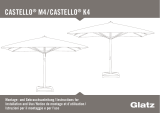 Glatz Castello M4 Manuel utilisateur
Glatz Castello M4 Manuel utilisateur
-
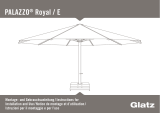 Glatz PALAZZO Royal E Installation and Use Manual
Glatz PALAZZO Royal E Installation and Use Manual
-
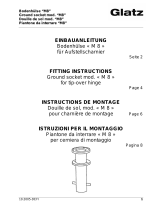 Glatz Ground socket mod. “M8” Manuel utilisateur
Glatz Ground socket mod. “M8” Manuel utilisateur
-
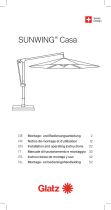 Glatz SUNWING CASA Manuel utilisateur
Glatz SUNWING CASA Manuel utilisateur
-
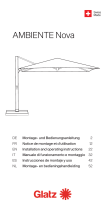 Glatz AMBIENTE NOVA Manuel utilisateur
Glatz AMBIENTE NOVA Manuel utilisateur
-
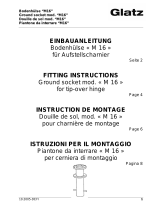 Glatz Ground socket mod. “M16” Manuel utilisateur
Glatz Ground socket mod. “M16” Manuel utilisateur
-
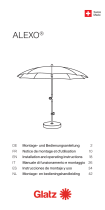 Glatz ALEXO Manuel utilisateur
Glatz ALEXO Manuel utilisateur
-
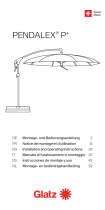 Glatz Pendalex P+ Manuel utilisateur
Glatz Pendalex P+ Manuel utilisateur
-
 Glatz Fortino Manuel utilisateur
Glatz Fortino Manuel utilisateur
-
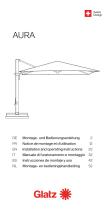 Glatz AURA Manuel utilisateur
Glatz AURA Manuel utilisateur
Autres documents
-
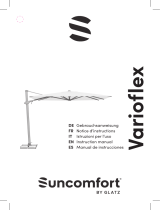 Suncomfort Varioflex Manuel utilisateur
Suncomfort Varioflex Manuel utilisateur
-
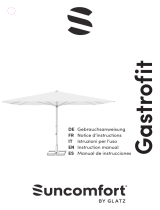 Suncomfort Glatz Parasol Fortello Easy Manuel utilisateur
Suncomfort Glatz Parasol Fortello Easy Manuel utilisateur
-
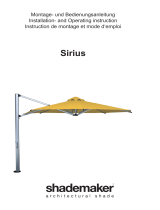 Shademaker Sirius Installation and Operating Instruction
Shademaker Sirius Installation and Operating Instruction
-
YOTRIO Offset Umbrella Assembly Instructions
-
LIVARNO 407809 Le manuel du propriétaire
-
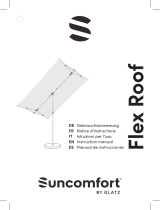 Bauhaus Flex Roof Manuel utilisateur
Bauhaus Flex Roof Manuel utilisateur
-
Extremis Inumbrina small Manuel utilisateur
-
Blum 10034739 Le manuel du propriétaire
-
Sony MPK-DVF5M Manuel utilisateur
-
ALDI 4832109900HD Manuel utilisateur





















































